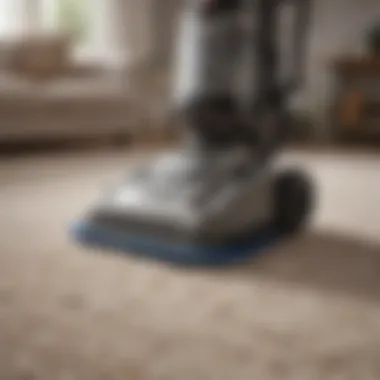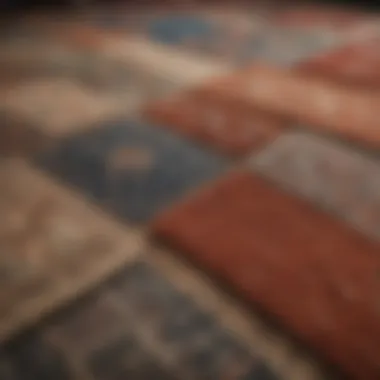Deep Cleaning Carpets: A Complete Home Guide


Intro
Deep cleaning carpets is often overlooked in daily housekeeping. However, it plays a crucial role in maintaining a fresh, healthy living environment. This guide aims to provide homeowners with the tools and techniques necessary to achieve impeccable carpet cleanliness. Understanding the importance of regular carpet cleaning not only extends the lifespan of your flooring but also enhances the overall aesthetic of your home.
Carpets can accumulate dirt, allergens, and stains over time. This build-up can lead to a decline in indoor air quality and contribute to various health issues. Therefore, a thorough cleaning process is essential. In the sections that follow, we will discuss various methodologies, necessary tools, and best practices tailored to different carpet types. The narrative will offer practical insights, emphasizing the significance of maintenance while equipping readers with actionable strategies.
Let us begin by exploring the different approaches to deep cleaning carpets effectively.
Prelude to Carpet Cleaning
Deep cleaning carpets is essential in maintaining a healthy home environment. Carpets act as air filters, trapping dust, allergens, and pollutants, which can affect indoor air quality. Regular cleaning ensures these harmful particles are removed, promoting better health for residents. Moreover, a clean carpet enhances the overall aesthetic of your living space. When guests enter your home, a well-kept carpet leaves a good impression.
Understanding the nuances of carpet types, their specific cleaning needs, and the benefits of regular maintenance is crucial. This foundational knowledge aids in the effective deep cleaning of carpets and prolongs their lifespan.
Understanding Carpet Types
Natural Fiber Carpets
Natural fiber carpets, made from materials like wool, cotton, or sisal, have unique characteristics that contribute to their desirability. They are often praised for their durability and natural resistance to stains and dirt.
Wool carpets, for example, are favored for their softness and warmth. They absorb moisture, which can prevent odors. However, they can be more expensive and require specific cleaning methods to avoid damage.
Synthetic Fiber Carpets
Synthetic fiber carpets, such as those made from nylon or polyester, are immensely popular due to their affordability and ease of maintenance. They resist stains more effectively than natural fibers, making them suitable for homes with pets or children.
A key advantage of synthetic carpets is their wide variety of colors and styles, allowing for creativity in interior design. However, they might not offer the same luxurious feel as natural fiber options.
Wool vs. Nylon
When comparing wool and nylon, there are clear distinctions. Wool carpets provide insulation and natural resilience, making them suitable for various climates. In contrast, nylon is known for its incredible durability and resistance to wear, which makes it a practical choice for high-traffic areas.
Both options come with advantages and disadvantages. Wool is softer but may be prone to moth damage, while nylon is tough but may not have the same comfort.
Importance of Regular Cleaning
Regular cleaning of carpets goes beyond aesthetics; it has significant health benefits. The accumulation of allergens and dust can lead to respiratory issues and other health concerns. Thus, frequent cleaning helps mitigate these risks.
Health Benefits
Cleaning carpets regularly can drastically reduce allergy triggers in the home. Dust mites and mold thrive in unclean carpets, posing health risks, especially for vulnerable individuals. Regular maintenance ensures a healthier living environment, which is particularly important for children and older adults.
Enhancing Aesthetic Appeal
Regular cleaning maintains the vibrance and texture of carpets, keeping them looking new. A clean carpet can elevate the entire room, enhancing your home’s aesthetics and comfort. It cultivates a welcoming atmosphere.
Extending Carpet Lifespan
Lastly, consistent cleaning prolongs the lifespan of carpets. Dirt and debris can wear down fibers, leading to early replacement. By investing in routine cleaning, you protect your investment, ultimately saving money in the long run. Regular deep cleaning keeps carpets in peak condition, making them last longer than they would otherwise.
Preparing for Deep Cleaning
Preparing for deep cleaning is an essential step in maintaining the integrity and appearance of your carpets. It ensures that the cleaning process is efficient, effective, and safe. By gathering the right tools and assessing the condition of your carpets, you set the groundwork for successful cleaning.
Gather Necessary Supplies
Cleaning Solutions
Cleaning solutions play a crucial role in carpet deep cleaning. They are formulated to target and break down dirt, stains, and odors ingrained in the fibers. The key characteristic of effective cleaning solutions is their ability to deliver powerful results without damaging the carpet.
Natural and eco-friendly options, like vinegar and baking soda, have gained popularity due to their low toxicity and effectiveness. However, it is essential to test any product beforehand to ensure it will not cause discoloration.
Equipment Required


The equipment required for deep cleaning encompasses a range of machines and tools. One of the more common options is a carpet cleaner. This equipment is designed to inject cleaning solution deep into the fibers, allowing for thorough extraction afterward.
The key characteristic of good carpet cleaning equipment is its suction strength. High-quality machines effectively remove both dirt and moisture, accelerating the drying process. However, a drawback can be their cost, which may not be justifiable for occasional cleaning.
Protective Gear
Using the right protective gear is fundamental during the cleaning process. Items such as gloves and masks safeguard against chemical exposure and irritation. The importance of protective gear is underscored by its ability to allow users to clean comfortably and without concern for personal safety.
Though they can feel cumbersome, protective garments ultimately promote a more pleasant cleaning experience.
Assessing Carpet Condition
Identifying Stains
Identifying stains is crucial for determining appropriate cleaning methods. Different stains require different treatments; for example, a red wine stain may need more vigorous treatment compared to a simple dirt mark. Understanding common stains allows you to strategize and choose the right products tailored to each issue. Familiarizing oneself with stains specific to one's home situation—like pet messes—can enhance cleaning outcomes.
Evaluating Wear and Tear
Evaluating wear and tear helps you ascertain the age and condition of your carpet. This process reveals areas needing particular attention. Regular assessments can extend a carpet's life by highlighting preventive maintenance needs before small issues escalate.
However, keep in mind that heavy wear may indicate the necessity for replacement rather than extensive cleaning.
Testing for Colorfastness
Testing for colorfastness is vital to maintain carpet aesthetics. This involves applying a small amount of cleaning solution to an inconspicuous area. Not all carpets respond the same way; some might bleed colors while others hold their dye well.
Testing ensures that you can proceed without risk, preserving both texture and vibrancy. This practice is particularly important when using commercial cleaning products that may be harsh.
Deep Cleaning Methods
Deep cleaning methods are fundamental in maintaining carpets. The right approach ensures effective removal of dirt, allergens and stains. This section highlights various techniques that maximize cleanliness and prolong carpet life.
Vacuuming Techniques
Vacuuming techniques set the foundation for carpet care. Proper vacuuming prevents dirt accumulation and prepares the surface for deeper cleaning. Regular and effective vacuuming diminishes future cleaning efforts.
Types of Vacuum Cleaners
There are various types of vacuum cleaners catering to different carpet types. Upright vacuums are popular for their strong suction and larger capacity. Canister vacuums offer flexibility, allowing users to clean various surfaces easily. Robotic vacuums are convenient for routine maintenance, although their deep cleaning power is limited. Each type has its unique benefits. For example, while upright vacuums work well on plush carpets, canister vacuums excel in areas with awkward spaces. Selecting the right type can greatly enhance cleaning results.
Optimal Vacuuming Patterns
Understanding optimal vacuuming patterns enhances cleaning efficiency. The back-and-forth or "S" pattern allows thorough dirt pickup. This pattern ensures no sections are missed, which might happen with random movements. Failing to follow an effective pattern can lead to uneven cleaning, leaving dirt behind. Adopting a systematic approach saves time and maximizes cleanliness in the long run.
Shampooing Carpets
Shampooing carpets offers a thorough clean, removing deep-seated dirt and stains. It revitalizes the fibers and enhances appearance significantly.
Best Practices for Application
Using the right technique is crucial for effective shampooing. Test the product first on a hidden area to avoid unwanted discoloration. Applying the shampoo in small sections prevents over-saturation. It's essential to use a brush or carpet cleaner to work the solution into the fibers effectively. Over-application can lead to residue issues, so moderation is key.
Choosing the Right Shampoo
Selecting the right shampoo enhances the cleaning process. Look for products suitable for your carpet type. Enzymatic shampoos are particularly effective against organic stains. Choosing the wrong shampoo may not yield desired cleaning results and can damage specific carpet types. Being informed about the ingredients helps in maintaining optimal carpet care.
Rinsing Techniques
Rinsing techniques play a significant role after shampooing. Proper rinsing removes leftover shampoo which can attract dirt if left behind. Using fresh, clean water ensures that all residues are effectively washed away. Rinsing should be done in the same “S” pattern to match the application. Failing to rinse adequately can lead to buildup and affect carpet texture and appearance.
Steam Cleaning Explained
Steam cleaning provides a powerful method of deep cleaning carpets. By using high-temperature steam, this process effectively loosens dirt and sanitizes the carpet fibers.
Equipment Overview
The equipment for steam cleaning is specialized. Carpet steamers are designed to inject steam into carpets, loosening dirt effectively. They also often include extraction features that pull dirty water out. The effectiveness of steam cleaning largely depends on the quality of the machine. High-capacity and efficient models are more effective in achieving desired results.
Step-by-Step Process


Following a structured step-by-step process ensures success in steam cleaning. Begin by vacuuming the carpet to remove loose dirt. Next, fill the machine with water and, if required, cleaning solution. Slowly move the steam cleaner across the carpet, allowing the steam to penetrate fibers. Finally, let the carpet dry thoroughly to avoid mold growth. Each step contributes to a comprehensive clean.
Benefits of Steam Cleaning
Steam cleaning offers numerous benefits. It not only cleans but also sanitizes carpets by killing bacteria and allergens. The use of steam means that fewer harsh chemicals are necessary, making it environmentally friendly. However, the drying time might be longer compared to other methods. The benefits often outweigh the cons, especially for households with pets or allergies.
Addressing Stains and Spots
Addressing stains and spots is a crucial aspect of maintaining your carpets. Stains can detract from the overall appearance of a room, and they may also negatively affect the longevity of the carpet. In this section, we will dive into how to effectively identify and manage different types of stains, ensuring cleanliness and aesthetics are upheld.
Identifying Common Stains
To effectively manage stains on your carpets, you must first identify them properly. Understanding the source of a stain often helps in determining the right cleaning methods.
Food and Beverage Stains
Food and beverage stains are among the most pervasive in household carpets. They come from various sources, such as sauces, drinks, and snacks. The key characteristic of food and beverage stains is their potential for rapid absorption into the carpet fibers, leading to set-in stains if not dealt with promptly. This aspect makes it vital to implement effective cleaning strategies quickly.
These stains can vary in difficulty to remove based on the food or drink involved. For example, red wine or tomato sauce may leave a lasting mark if allowed to sit. The unique feature of food and beverage stains is the wide array of solutions available, ranging from DIY methods to commercial products designed for specific stain types.
Pet-related Stains
Pet-related stains present a different challenge, often accompanied by odors as well. The specific aspect of these stains revolves around urine, feces, or vomit from pets. The key characteristic of pet-related stains is their potential to cause significant damage not only to the appearance of the carpet but also to its underlying fibers. Ignoring these stains can lead to long-term odor issues.
Why it is essential to address pet-related stains quickly: Delaying treatment can lead to permanent discoloration and lingering smells. The unique feature of these stains is their combination of both visible coloration and invisible odors, which necessitates comprehensive cleaning techniques.
Organic Stains
Organic stains are those that originate from plant or animal materials, such as juice, milk, or even grass. These stains can pose various concerns related to removal, prompting a thoughtful approach in cleaning. The key characteristic of organic stains is their biochemical nature, which can lead to not just discoloration but also mold growth if moisture is left unattended.
Being proactive in dealing with organic stains can prevent bigger issues later. Their unique feature is that they often require specific, pH-balanced cleaning agents to effectively break down the organic material without damaging the carpet fibers.
Effective Spot Cleaning Techniques
Once you have identified the type of stain on your carpet, the next step is choosing an effective spot cleaning technique. Different approaches will suit different stain types, so understanding your options is key.
DIY Solutions
DIY solutions often utilize common household items, such as vinegar or baking soda, to tackle stains. The specific aspect of DIY solutions is their accessibility and cost-effectiveness. Many homeowners may find these methods appealing for quick fixes without the need for purchasing specialized products.
Key Characteristics: DIY solutions can be both gentle on the carpet and tough on stains if used properly. However, a disadvantage is that they may not always produce the same level of effectiveness as some commercial solutions, particularly for tougher stains.
Commercial Products
Commercial products are formulated specifically for targeted stain removal, offering a range of choices for consumers. The specific aspect of these products is their ability to tackle various stain types efficiently. Many brands on the market provide user guidelines to direct their application toward specific challenges.
Benefits: Commercial products often contain enzymes or special active ingredients designed to break down stubborn stains. On the downside, they can sometimes be harsh on certain carpet materials, which makes testing in a hidden area imperative before applying widely.
Application Methods
Application methods play a crucial role in stain remediation. The specific aspect involves deciding how to best apply cleaning agents for maximum efficacy. Common methods include blotting, scrubbing, and soaking. The key characteristic of effective application is to minimize damage to the carpet while ensuring the stain is lifted.
One unique feature of these methods is the varying intensity; some stains may require gentle blotting, while others could benefit from a bit of scrubbing to loosen the material. It is critical to follow all instructions when using both DIY and commercial products to avoid further issues.
Remember, addressing stains promptly not only preserves your carpet’s appearance but also contributes to a healthier living environment.
Post-Cleaning Maintenance
Post-cleaning maintenance is a crucial aspect of caring for your carpets after a thorough deep clean. It ensures the longevity of your carpets and helps maintain a clean and healthy environment. This section will cover essential techniques and practices to adopt after cleaning your carpets.
Drying Techniques


Air Drying vs. Machine Drying
Drying techniques play a vital role in the overall cleaning process. Air drying is a common method, as it involves allowing the carpet to dry naturally by circulating air around it. This method is beneficial because it minimizes the risk of mold and mildew growth that often arises with excessive moisture. On the other hand, machine drying uses equipment like carpet dryers to expedite the drying process. While this method is faster, it can generate some heat which may not be suitable for all carpet types. Thus, individuals should consider the specific characteristics of their carpet when deciding on a drying technique. Both methods have their advantages and disadvantages.
- Air Drying Advantages:
- Machine Drying Disadvantages:
- Reduces the risk of mold formation.
- Easier on delicate fibers.
- Potential for heat damage.
- Can be overkill for minor spills.
Ensuring Proper Ventilation
Proper ventilation is essential for effective drying and overall carpet maintenance. When drying carpets, ensuring adequate airflow can significantly reduce drying time and prevent unpleasant odors. Opening windows or using fans creates an environment where moisture escapes more rapidly. Additionally, good ventilation also helps eliminate allergens that may have been trapped in the carpet fibers. This practice not only helps with the drying process but also contributes to a healthier indoor atmosphere.
- Benefits of Proper Ventilation:
- Considerations for Ventilation:
- Enhances the drying process.
- Reduces odors associated with damp carpets.
- Weather conditions can affect effectiveness.
- Indoor humidity levels should be monitored.
Regular Maintenance Practices
Regular maintenance practices are fundamental to preserving the state of your carpet over time. Consistent upkeep can prevent the accumulation of dirt and stains, making deep cleaning less frequent and less intensive.
Vacuuming Frequency
Establishing a vacuuming routine is necessary. Depending on foot traffic, homes may require vacuuming several times a week. Frequent vacuuming lifts dirt, dust, and allergens, ultimately enhancing the health benefits of your living space. Establishing this habit can keep the carpet looking fresh while also prolonging its lifespan. Advanced vacuum cleaners can also provide deep cleaning capabilities and may offer multiple settings for different carpet types.
- Key Aspects of Vacuuming Frequency:
- Reduces stain formation by minimizing dirt buildup.
- Retains carpet appearance longer.
Professional Cleaning Recommendations
While regular vacuuming is important, professional cleaning is also recommended. Experts suggest carpet maintenance every 12 to 18 months, depending on usage. Professional services use specialized equipment and solutions that can reach deeper levels of dirt and stains, which household methods cannot effectively address. This ensures that carpets remain in optimal condition without degrading the fibers.
- Advantages of Professional Cleaning:
- Removes deeply embedded dirt and allergens.
- Extends the life of your carpets.
Protective Treatments
Protective treatments can be applied after cleaning to further enhance the carpet's resilience against stains and dirt. Many products are available that offer water and stain resistance. Such treatments create a barrier that makes it easier to clean spills and reduces the gentler fibers' wear and tear. Applying these products correctly can lead to long-term benefits for your carpets.
- Benefits of Protective Treatments:
- Eases cleaning for future spills.
- Reduces stain visibility and carpet degradation.
Finale and Final Thoughts
Evaluating Your Cleaning Routine
To create an effective carpet cleaning strategy, evaluation is key. Begin by examining how often you clean your carpets and the methods you apply. Regular vacuuming is essential; however, deep cleaning should occur at least once every 6 to 12 months. Over time, accumulate insights on which methods yield the best results, be it steam cleaning, shampooing, or a combination of both.
Keep track of stains that frequently occur and identify the cleaning solutions that worked best in addressing them. Adjust your routine as necessary, and consider seasonal changes that may affect your carpet’s condition. For example, if you have pets, you may need to include more frequent cleaning sessions, especially during shedding seasons. Over time, you will develop a refined routine tailored to your specific environment and carpet types.
The Impact of a Clean Carpet
Clean carpets have significant benefits that extend beyond mere aesthetics. First and foremost, a clean carpet promotes better indoor air quality. Carpets can trap allergens, dust, and contaminants, which can be harmful to health. Regular cleaning reduces these particulates, creating a healthier environment, especially for sensitive individuals.
Moreover, a well-maintained carpet enhances the overall ambiance of your living space. It contributes positively to the aesthetic appeal and can even increase the value of a property. When potential buyers view a house with pristine carpets, they often perceive it to be well-maintained and cared for, influencing their buying decisions.
In summary, effective carpet cleaning practices not only enhance the lifespan of your carpets but also significantly improve your home's health and value.
"Regular maintenance is the key to extending the life of your carpets. A clean carpet is a healthy carpet."
With a solid understanding of cleaning methods and a commitment to regular maintenance, you can enjoy the many benefits of clean carpets. Embrace the strategies discussed in this guide, and elevate your approach to carpet care.







